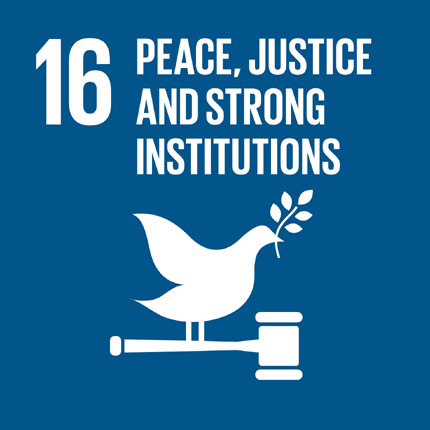sdg16
SUSTAINABLE DEVELOPMENT GOAL 16
Promote peaceful and inclusive societies for sustainable development, provide access to justice for all and build effective, accountable and inclusive institutions at all levels
Progress of goal 16
- Peace, justice and effective, accountable and inclusive institutions are at the core of sustainable development. Several regions have enjoyed increased and sustained levels of peace and security in recent decades. But many countries still face protracted armed conflict and violence, and far too many people struggle as a result of weak institutions and the lack of access to justice, information and other fundamental freedoms.
- The number of victims of intentional homicide worldwide remained relatively stable from 2008 to 2014. The worldwide number of victims of intentional homicide was estimated to be between 4.6 and 6.8 per 100,000 people in 2014, a slight decrease with respect to previous years. Yet during that period, the homicide rate in developing countries was twice that in developed countries, and increased in the least developed countries. Moreover, despite the lack of harmonized data, fatalities and injuries related to armed conflict appear to be increasing in some countries, causing unprecedented population displacements and enormous humanitarian needs.
- Various forms of violence against children are pervasive, including discipline that relies on physical punishment and psychological aggression. In all but 7 of 73 countries and areas with available survey data from 2005 to 2015, more than half of children between the ages of 1 and 14 were subjected to some form of psychological aggression and/or physical punishment at home. In Northern Africa, the share was more than 90 per cent.
- Globally, the share of girls and boys among victims of human trafficking (21 per cent and 13 per cent, respectively) peaked in 2011. By 2014, the figures had dropped to 18 per cent and 7 per cent, respectively, but were still almost twice the levels recorded for 2004.
- Sexual violence is one of the most unsettling of children’s rights violations. Yet underreporting and the lack of comparable data limit understanding of the full extent of the problem. Survey data from 31 low- and middle-income countries suggest that the proportion of women aged between 18 and 29 who experienced sexual violence for the first time before the age of 18 varies widely, ranging from zero to 16 per cent. Comparable data on the experiences of men are only available for five countries, but values are lower than those reported among women in the same countries.
- Progress with respect to the rule of law and access to justice is mixed. Globally, the proportion of people held in detention without sentencing decreased slightly, from 32 per cent of total detainees in 2003-2005 to 30 per cent in 2012-2014. However, the percentage for developing regions has consistently been more than two times that of developed regions. In Southern Asia, for instance, more than 2 out of 3 prisoners remained unsentenced in 2012-2014, despite some improvement over the data available for the period 2003 to 2005.
- Among victims of robbery, between one quarter and one half reported the crime to the police, in 27 countries with available data. The data suggest a significant gap in citizens’ access to and trust in authorities. Although official data on the prevalence of bribery are limited, figures from 19 countries indicate that the rate of prevalence of bribery may reach as high as 50 per cent among citizens who had contact with public officials, undermining trust in state institutions.
- Registering children at birth is a first step in securing recognition before the law and safeguarding individual rights and access to justice. Despite recent progress, the births of more than 1 in 4 children under the age of 5 worldwide have not been recorded. In sub-Saharan Africa, over half (54 per cent) of children have not been registered by their fifth birthday. Globally, children living in urban areas are around 1.5 times more likely to be registered than their rural counterparts. In most regions, birth registration rates tend to be highest among the richest 20 per cent of the population.
- Efforts are under way to make national and international institutions more effective, inclusive and transparent. Over the past 10 years, nearly two thirds of 144 countries with available data were able to plan their national budgets effectively (where final expenses remained within 10 per cent of original budgets). Voting rights assigned to various groups of countries in international institutions is one indication of inclusivity at the international level. For example, while developing countries account for 63 per cent of voting rights in the African Development Bank, this figure is only 35 per cent in the International Monetary Fund and 38 per cent in the International Bank for Reconstruction and Development of the World Bank Group.
- A free press is closely linked to access to information and the protection of human rights, but the trend in this regard is discouraging. The number of journalists killed increased from 65 in 2010 to 114 in 2015, despite the fact that, by 2013, 90 States had adopted laws on freedom of and/or access to information.
- The proportion of countries with national human rights institutions has doubled over the past 15 years, reaching 35.5 per cent by the end of 2015. The share of such institutions that are compliant with the principles relating to the status of national institutions for the promotion and protection of human rights (Paris Principles) (adopted by the General Assembly in its resolution 48/134) was highest in developed regions (46 per cent) and in Latin America and the Caribbean (41 per cent).
Source: United Nations, Department of Economic and Social Affairs, SUSTAINABLE DEVELOPMENT KNOWLEDGE PLATFORM
The National Indicators for Sustainable Development Goal 16 are:
- Significantly reduce all forms of violence and related death rates everywhere
- Promote the rule of law at the national and international levels and ensure equal access to justice for all
- Death rate due to homicide by sex - number par 100 000 persons
- Population reporting occurrence of crime, violence or vandalism in their area by poverty status
- General government total expenditure on law courts (in Million Euro)
All available data in .xls file:
- Peace, justice and strong institutions
Last Updated: 29/4/2025
EU SDG indicator set
To measure SDG achievement in an EU context, an EU SDG indicator set was developed under the leadership of Eurostat. The purpose of this set, which is structured along the 17 global Sustainable Development Goals, is to monitor progress towards the SDGs at the European level.
- For the complete set of indicators available in the Eurostat database, click here.
- To compare Greece’s progress on specific indicators for each Sustainable Development Goal, click here [data visualisation].

